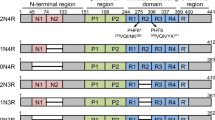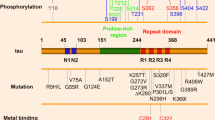Abstract
The Hsp90-associated cis-trans peptidyl-prolyl isomerase—FK506 binding protein 51 (FKBP51)—was recently found to co-localize with the microtubule (MT)-associated protein tau in neurons and physically interact with tau in brain tissues from humans who died from Alzheimer’s disease (AD). Tau pathologically aggregates in neurons, a process that is closely linked with cognitive deficits in AD. Tau typically functions to stabilize and bundle MTs. Cellular events like calcium influx destabilize MTs, disengaging tau. This excess tau should be degraded, but sometimes it is stabilized and forms higher-order aggregates, a pathogenic hallmark of tauopathies. FKBP51 was also found to increase in forebrain neurons with age, further supporting a novel role for FKBP51 in tau processing. This, combined with compelling evidence that the prolyl isomerase Pin1 regulates tau stability and phosphorylation dynamics, suggests an emerging role for isomerization in tau pathogenesis.

Similar content being viewed by others
References
Oddo S et al (2003) Triple-transgenic model of Alzheimer’s disease with plaques and tangles: intracellular Abeta and synaptic dysfunction. Neuron 39(3):409–421
Frautschy SA, Baird A, Cole GM (1991) Effects of injected Alzheimer beta-amyloid cores in rat brain. Proc Natl Acad Sci U S A 88(19):8362–8366
Roberson ED et al (2011) Amyloid-beta/Fyn-induced synaptic, network, and cognitive impairments depend on tau levels in multiple mouse models of Alzheimer's disease. J Neurosci 31(2):700–711
Mukaetova-Ladinska EB et al (2000) Alpha-synuclein inclusions in Alzheimer and Lewy body diseases. J Neuropathol Exp Neurol 59(5):408–417
Braak H, Braak E (1991) Neuropathological stageing of Alzheimer-related changes. Acta Neuropathol 82(4):239–259
Hardy J et al (2006) Tangle diseases and the tau haplotypes. Alzheimer Dis Assoc Disord 20(1):60–62
Simon-Sanchez J et al (2009) Genome-wide association study reveals genetic risk underlying Parkinson's disease. Nat Genet 41(12):1308–1312
Shimura H, Miura-Shimura Y, Kosik KS (2004) Binding of tau to heat shock protein 27 leads to decreased concentration of hyperphosphorylated tau and enhanced cell survival. J Biol Chem 279(17):17957–17962
Shimura H et al (2004) CHIP-Hsc70 complex ubiquitinates phosphorylated tau and enhances cell survival. J Biol Chem 279(6):4869–4876
Carrettiero DC et al (2009) The cochaperone BAG2 sweeps paired helical filament-insoluble tau from the microtubule. J Neurosci 29(7):2151–2161
Petrucelli L et al (2004) CHIP and Hsp70 regulate tau ubiquitination, degradation and aggregation. Hum Mol Genet 13(7):703–714
Dickey CA et al (2006) Pharmacologic reductions of total tau levels; implications for the role of microtubule dynamics in regulating tau expression. Mol Neurodegener 1:6
Dickey CA et al (2006) HSP induction mediates selective clearance of tau phosphorylated at proline-directed Ser/Thr sites but not KXGS (MARK) sites. FASEB J 20(6):753–755
Dickey CA et al (2008) Akt and CHIP coregulate tau degradation through coordinated interactions. Proc Natl Acad Sci U S A 105(9):3622–3627
Dickey CA, Petrucelli L (2006) Current strategies for the treatment of Alzheimer's disease and other tauopathies. Expert Opin Ther Targets 10(5):665–676
Dickey CA et al (2006) Deletion of the ubiquitin ligase CHIP leads to the accumulation, but not the aggregation, of both endogenous phospho- and caspase-3-cleaved tau species. J Neurosci 26(26):6985–6996
Dou F et al (2003) Chaperones increase association of tau protein with microtubules. Proc Natl Acad Sci U S A 100(2):721–726
Luo W et al (2007) Roles of heat-shock protein 90 in maintaining and facilitating the neurodegenerative phenotype in tauopathies. Proc Natl Acad Sci U S A 104(22):9511–9516
Jinwal UK et al (2010) The Hsp90 cochaperone, FKBP51, increases Tau stability and polymerizes microtubules. J Neurosci 30(2):591–599
Jinwal UK et al (2010) Hsp70 ATPase modulators as therapeutics for Alzheimer's and other neurodegenerative diseases. Mol Cell Pharmacol 2(2):43–46
Jinwal UK et al (2010) Hsc70 rapidly engages tau after microtubule destabilization. J Biol Chem 285(22):16798–16805
Wang CL, Yang HL (2011) Conserved residues in the subunit interface of tau glutathione s-transferase affect catalytic and structural functions. J Integr Plant Biol 53(1):35–43
Lu KP, Zhou XZ (2007) The prolyl isomerase PIN1: a pivotal new twist in phosphorylation signalling and disease. Nat Rev Mol Cell Biol 8(11):904–916
Lu PJ et al (1999) The prolyl isomerase Pin1 restores the function of Alzheimer-associated phosphorylated tau protein. Nature 399(6738):784–788
Romero PR et al (2006) Alternative splicing in concert with protein intrinsic disorder enables increased functional diversity in multicellular organisms. Proc Natl Acad Sci U S A 103(22):8390–8395
Galas MC et al (2006) The peptidylprolyl cis/trans-isomerase Pin1 modulates stress-induced dephosphorylation of Tau in neurons. Implication in a pathological mechanism related to Alzheimer disease. J Biol Chem 281(28):19296–19304
Pei H et al (2009) FKBP51 affects cancer cell response to chemotherapy by negatively regulating Akt. Cancer Cell 16(3):259–266
Harding MW et al (1989) A receptor for the immunosuppressant FK506 is a cis-trans peptidyl-prolyl isomerase. Nature 341(6244):758–760
Sugata H et al (2009) A peptidyl-prolyl isomerase, FKBP12, accumulates in Alzheimer neurofibrillary tangles. Neurosci Lett 459(2):96–99
Yoshiyama Y et al (2007) Synapse loss and microglial activation precede tangles in a P301S tauopathy mouse model. Neuron 53(3):337–351
Armistead DM et al (1995) Design, synthesis and structure of non-macrocyclic inhibitors of FKBP12, the major binding protein for the immunosuppressant FK506. Acta Crystallogr D Biol Crystallogr 51(Pt 4):522–528
Zhao L et al (2006) FK506-binding protein ligands: structure-based design, synthesis, and neurotrophic/neuroprotective properties of substituted 5,5-dimethyl-2-(4-thiazolidine)carboxylates. J Med Chem 49(14):4059–4071
Davies TH, Ning YM, Sanchez ER (2005) Differential control of glucocorticoid receptor hormone-binding function by tetratricopeptide repeat (TPR) proteins and the immunosuppressive ligand FK506. Biochemistry 44(6):2030–2038
Davies TH, Sanchez ER (2005) FKBP52. Int J Biochem Cell Biol 37(1):42–47
Chambraud B et al (2010) A role for FKBP52 in Tau protein function. Proc Natl Acad Sci U S A 107(6):2658–2663
Quinta HR et al (2010) Subcellular rearrangement of hsp90-binding immunophilins accompanies neuronal differentiation and neurite outgrowth. J Neurochem 115(3):716–734
Ruan B et al (2008) Binding of rapamycin analogs to calcium channels and FKBP52 contributes to their neuroprotective activities. Proc Natl Acad Sci U S A 105(1):33–38
Chambraud B et al (2007) The immunophilin FKBP52 specifically binds to tubulin and prevents microtubule formation. FASEB J 21(11):2787–2797
Yong W et al (2007) Essential role for co-chaperone Fkbp52 but not Fkbp51 in androgen receptor-mediated signaling and physiology. J Biol Chem 282(7):5026–5036
Binder EB et al (2008) Association of FKBP5 polymorphisms and childhood abuse with risk of posttraumatic stress disorder symptoms in adults. JAMA 299(11):1291–1305
Nielsen JV et al (2004) Fkbp8: novel isoforms, genomic organization, and characterization of a forebrain promoter in transgenic mice. Genomics 83(1):181–192
Shirane M et al (2008) Regulation of apoptosis and neurite extension by FKBP38 is required for neural tube formation in the mouse. Genes Cells 13(6):635–651
Edlich F et al (2006) The specific FKBP38 inhibitor N-(N',N'-dimethylcarboxamidomethyl)cycloheximide has potent neuroprotective and neurotrophic properties in brain ischemia. J Biol Chem 281(21):14961–14970
Fischer G, Bang H, Mech C (1984) Determination of enzymatic catalysis for the cis-trans-isomerization of peptide binding in proline-containing peptides. Biomed Biochim Acta 43(10):1101–1111
Fischer G et al (1989) Cyclophilin and peptidyl-prolyl cis-trans isomerase are probably identical proteins. Nature 337(6206):476–478
Handschumacher RE et al (1984) Cyclophilin: a specific cytosolic binding protein for cyclosporin A. Science 226(4674):544–547
Takahashi N, Hayano T, Suzuki M (1989) Peptidyl-prolyl cis-trans isomerase is the cyclosporin A-binding protein cyclophilin. Nature 337(6206):473–475
Ortiz M et al (2006) Patterns of evolution of host proteins involved in retroviral pathogenesis. Retrovirology 3:11
Ke H, Huai Q (2004) Crystal structures of cyclophilin and its partners. Front Biosci 9:2285–2296
Kim IS et al (2011) A cyclophilin A CPR1 overexpression enhances stress acquisition in Saccharomyces cerevisiae. Mol Cells 29(6):567–574
Lian Q et al (2001) Selective changes of calcineurin (protein phosphatase 2B) activity in Alzheimer's disease cerebral cortex. Exp Neurol 167(1):158–165
Barinaga M (1991) The secret of saltiness. Science 254(5032):654–655
Galigniana MD et al (2004) Cyclophilin-A is bound through its peptidylprolyl isomerase domain to the cytoplasmic dynein motor protein complex. J Biol Chem 279(53):55754–55759
Barrientos SA et al (2011) Axonal degeneration is mediated by the mitochondrial permeability transition pore. J Neurosci 31(3):966–978
Pirkl F, Buchner J (2001) Functional analysis of the Hsp90-associated human peptidyl prolyl cis/trans isomerases FKBP51, FKBP52 and Cyp40. J Mol Biol 308(4):795–806
Li J, Richter K, Buchner J (2011) Mixed Hsp90-cochaperone complexes are important for the progression of the reaction cycle. Nat Struct Mol Biol 18(1):61–66
Ratajczak T et al (2009) Cyclophilin 40: an Hsp90-cochaperone associated with apo-steroid receptors. Int J Biochem Cell Biol 41(8–9):1652–1655
Kimmins S, MacRae TH (2000) Maturation of steroid receptors: an example of functional cooperation among molecular chaperones and their associated proteins. Cell Stress Chaperones 5(2):76–86
Naylor DJ, Hoogenraad NJ, Hoj PB (1999) Characterisation of several Hsp70 interacting proteins from mammalian organelles. Biochim Biophys Acta 1431(2):443–450
Lane-Guermonprez L et al (2005) Synapsin associates with cyclophilin B in an ATP- and cyclosporin A-dependent manner. J Neurochem 93(6):1401–1411
Morot-Gaudry-Talarmain Y (2009) Physical and functional interactions of cyclophilin B with neuronal actin and peroxiredoxin-1 are modified by oxidative stress. Free Radic Biol Med 47(12):1715–1730
Bergsma DJ et al (1991) The cyclophilin multigene family of peptidyl-prolyl isomerases. Characterization of three separate human isoforms. J Biol Chem 266(34):23204–23214
Ozaki K et al (1996) Cloning, expression and chromosomal mapping of a novel cyclophilin-related gene (PPIL1) from human fetal brain. Cytogenet Cell Genet 72(2–3):242–245
Carson R et al (2009) Variation in RTN3 and PPIL2 genes does not influence platelet membrane beta-secretase activity or susceptibility to alzheimer's disease in the northern Irish population. Neuromolecular Med 11(4):337–344
Zeng L et al (2001) Molecular cloning, structure and expression of a novel nuclear RNA-binding cyclophilin-like gene (PPIL4) from human fetal brain. Cytogenet Cell Genet 95(1–2):43–47
Nagase T et al (1999) Prediction of the coding sequences of unidentified human genes. XV. The complete sequences of 100 new cDNA clones from brain which code for large proteins in vitro. DNA Res 6(5):337–345
Meza-Zepeda LA et al (2002) Positional cloning identifies a novel cyclophilin as a candidate amplified oncogene in 1q21. Oncogene 21(14):2261–2269
Shmueli O et al (2003) GeneNote: whole genome expression profiles in normal human tissues. C R Biol 326(10–11):1067–1072
Yanai I et al (2005) Genome-wide midrange transcription profiles reveal expression level relationships in human tissue specification. Bioinformatics 21(5):650–659
Chen S et al (1998) Differential interactions of p23 and the TPR-containing proteins Hop, Cyp40, FKBP52 and FKBP51 with Hsp90 mutants. Cell Stress Chaperones 3(2):118–129
Mi H et al (1996) A nuclear RNA-binding cyclophilin in human T cells. FEBS Lett 398(2–3):201–205
Zhou Z et al (2001) Molecular cloning and characterization of a novel peptidylprolyl isomerase (cyclophilin)-like gene (PPIL3) from human fetal brain. Cytogenet Cell Genet 92(3–4):231–236
Acknowledgments
Work supported by NIH R01NS073899 and R00AG031291, The Abe and Irene Pollin/CurePSP Fund, AFAR, and Alzheimer's Association.
Author information
Authors and Affiliations
Corresponding author
Rights and permissions
About this article
Cite this article
Koren, J., Jinwal, U.K., Davey, Z. et al. Bending Tau into Shape: The Emerging Role of Peptidyl-Prolyl Isomerases in Tauopathies. Mol Neurobiol 44, 65–70 (2011). https://doi.org/10.1007/s12035-011-8182-4
Received:
Accepted:
Published:
Issue Date:
DOI: https://doi.org/10.1007/s12035-011-8182-4




